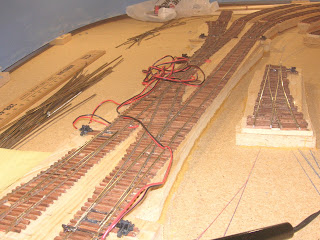




I've made some slight modifications to my original plan, specifically eliminating three turnouts that are unnecessary. They branched into short...too short...storage sidings near the roundhouse. One turnout will do. So that leaves five additional turnouts I must build. I've started on the components, beginning with the frogs.
My turnouts use "hot" frogs; that is, they are continuously powered and their polarity is subject to the position of the turnout's point rails (more about that in a future post). I use a block of white pine, soft wood that will readily accept spikes, and lay out the frog angle. I only use #6 frogs, so the spread is one-sixth of any given distance from the point of the "vee" in the frog. In practice, I measure six fourths from the vee point and then a width of one fourth. I then spike down one rail along one axis and cut it at the same angle as the other axis, thus producing a perfect No. 6 angle in the vee point. Next, I file a second rail to fit along the second axis. Finally, I add the wing rails.
Now I'm ready to solder. I fill the frog assembly with solder and then file it out to flange depth. I find this makes for a very accurate frog and, though I of course use guard rails, cars seem to go through my frogs correctly even without them.
The photos will, I hope, make all this more clear. From top to bottom...
Photo #1, 2
A finished and installed frog. After soldering and filing, I trim the rails so that the frog assembly is a scale 15 feet long, about 3 inches in S Scale.
Photo #3
The frog assembly before soldering.
Photo #4,5
A frog assembly during the flangeway filing process.




